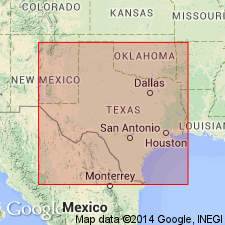
- Usage in publication:
-
- Camp Creek bed
- Modifications:
-
- Original reference
- Dominant lithology:
-
- Clay
- Limestone
- AAPG geologic province:
-
- Bend arch
Summary:
Pg. 387, 416. Camp Creek bed in Cisco division. Red and yellowish sandy clay, with some thin layers of limestone in places and a little sandstone. Fossiliferous; contains CAMPOPHYLLUM TORQUIUM corals. Thickness 40 to 50 feet. Member of Cisco division [Cisco is 2nd from top of 5 Carboniferous divisions of Cummins, 1891]. Underlies Coon Mountain bed and overlies Saddle Creek bed. Age is Pennsylvanian.
[Named from Camp Creek, Coleman Co., Colorado River region, central TX.]
Source: Publication; US geologic names lexicon (USGS Bull. 896, p. 326).
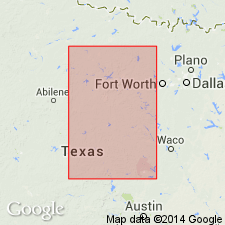
- Usage in publication:
-
- Camp Creek shale member
- Modifications:
-
- Revised
- AAPG geologic province:
-
- Bend arch
Summary:
Pg. 24, 31; Univ. Texas Bull., no. 2132, p. 172 and charts. Camp Creek shale member, basal member of Pueblo formation of Cisco group. Underlies Stockwether limestone, the Coon Mountain bed of Drake (1893) having proved to be largely Cretaceous sands overlapping several Pennsylvanian beds. Not recognized in Brazos River Valley. Age is Pennsylvanian. Report includes stratigraphic chart.
Source: US geologic names lexicon (USGS Bull. 896, p. 326); supplemental information from GNU records (USGS DDS-6; Denver GNULEX).
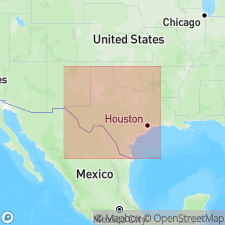
- Usage in publication:
-
- Camp Creek shale member*
- Modifications:
-
- Revised
- AAPG geologic province:
-
- Bend arch
Summary:
Pg. 103. Camp Creek shale member of Pueblo formation. Treated Camp Creek shale of Drake as basal member of Pueblo formation, underlying Coon Mountain sandstone and overlying Saddle Creek shale. [Age is Pennsylvanian.]
Source: US geologic names lexicon (USGS Bull. 896, p. 326).
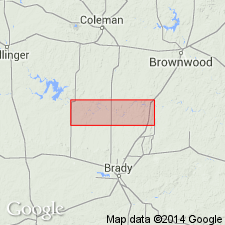
- Usage in publication:
-
- Camp Creek shale member
- Modifications:
-
- Revised
- AAPG geologic province:
-
- Bend arch
Summary:
Pg. 197+. Defined Camp Creek shale member of Pueblo formation as including all beds beneath Stockwether limestone member and above Saddle Creek shale. [Age is Pennsylvanian.]
Source: US geologic names lexicon (USGS Bull. 896, p. 326).
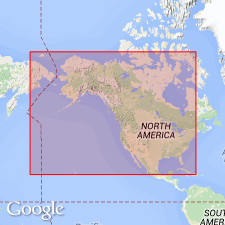
- Usage in publication:
-
- Camp Creek shale member*
- Modifications:
-
- Overview
- AAPG geologic province:
-
- Bend arch
Summary:
The present [ca. 1936] definition of the USGS treats Camp Creek shale member as basal member of Pueblo formation. It underlies Coon Mountain sandstone member and overlies Saddle Creek shale member of Harpersville formation. Recognized in Colorado River region, central Texas. Age is Pennsylvanian.
Source: US geologic names lexicon (USGS Bull. 896, p. 326).
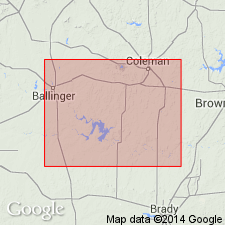
- Usage in publication:
-
- Camp Creek shale member*
- Modifications:
-
- Revised
- Biostratigraphic dating
- AAPG geologic province:
-
- Bend arch
- Llano uplift
Summary:
Sheet 2. Camp Creek shale member of Pueblo formation. Consists of red and gray shale, a little sandstone and several thin beds of gray limestones; species of SCHWAGERINA occur in zones from base to top. Average thickness about 80 feet. Lowermost subdivision is shale which attains thickness of 8 to 12 feet in McCulloch County, central Texas, but thins to 1 or 2 feet north of Colorado River, so as to bring overlying limestone beds of Camp Creek shale member close to Saddle Creek limestone; these limestone beds of the Camp Creek have been included with the Saddle Creek in eastern Coleman County and northward. Underlies Stockwether member. ARTINSKIA LILIANAC Miller and Unklesbay, collected in northwestern McCulloch County, 20 feet above base of member, represents stratigraphically lowest known occurrences of this genus in North America. ARTINSKIA is judged to indicate post-Pennsylvanian age of beds in which it occurs. Age is Early Permian (Wolfcamp).
Source: Publication; US geologic names lexicon (USGS Bull. 1200, p. 595-596).
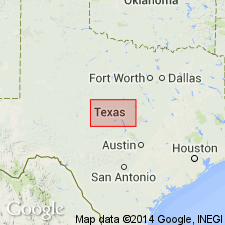
- Usage in publication:
-
- Camp Creek Shale [unranked]
- Modifications:
-
- Areal extent
- AAPG geologic province:
-
- Bend arch
Summary:
Camp Creek Shale [unranked] in Pueblo Formation of Cisco Group. Not described. Shown on schematic cross section in lower part of formation, between Stockwether Limestone above and Saddle Creek Limestone below [both unranked]. Age is Early Permian (Wolfcampian).
Source: Publication.
For more information, please contact Nancy Stamm, Geologic Names Committee Secretary.
Asterisk (*) indicates published by U.S. Geological Survey authors.
"No current usage" (†) implies that a name has been abandoned or has fallen into disuse. Former usage and, if known, replacement name given in parentheses ( ).
Slash (/) indicates name conflicts with nomenclatural guidelines (CSN, 1933; ACSN, 1961, 1970; NACSN, 1983, 2005, 2021). May be explained within brackets ([ ]).

